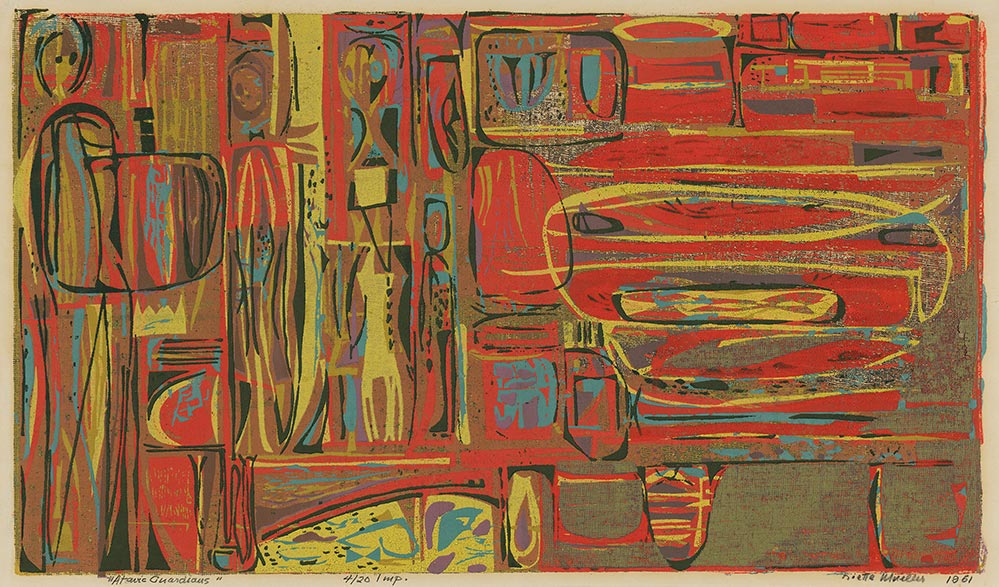63. Henriette Waters Mueller
| Life Dates | 1915-2009 |
| Place of Birth | Glen Osborne, PA |
| Place of Death | Boulder, CO, USA |
| Birth Name | Henriette Waters |
Henriette Waters was born in Glen Osborne, Pennsylvania, a small borough on the Allegheny River just outside of Pittsburgh. Her family eventually settled in Chicago by way of Buffalo, New York, where her father was an electrical engineer. She attended Northwestern University (1933-36) and also studied at the School of the Art Institute of Chicago with a concentration in printmaking. After graduating, she joined the faculty at Colby Junior College (now Colby-Sawyer College) in New London, Connecticut, and there she met her future husband Werner Mueller (1903-1999), fellow faculty in the foreign language department and scholar of German and classical literature.1 The couple married in June 1940, and ultimately settled at the University of Wyoming, Laramie, where he earned a faculty appointment.2 Although she was eminently qualified, Henrietta Mueller could never hold a full-time position at the university because of an institutional nepotism clause.3 Instead, she pursued coursework—earning a masters degree in art in August 1948 and a masters in education in May 1960—and taught courses periodically. Nevertheless, she was very involved in university’s art department, which was bustling hub of modernist education during the 1940s and 1950s with eminent artists like Ilya Bolotowsky and Ad Reinhart teaching there. She and Worden Day became friends during the time Day held the position of assistant professor between 1949 and 1952.4 Perhaps through Day’s encouragement, Mueller began entering her artwork into national competitions and, through the 1950s, she built an extensive list of participation in group print exhibitions (annuals at the Brooklyn Museum, Philadelphia Print Club, Northwest Printmakers, American Color Print Society).5 Her work was always abstract and, like Day’s, references features of the American West’s landscape. In 1950, she also had a painting titled The Land of Unlikeness accepted into the Metropolitan Museum of Art’s nationally competitive American Painting Today (Day, too, won entry for a painting).6 In June 1952, Mueller came to New York City—while her husband and two sons vacationed in Maine—to pursue study at Atelier 17. Living with Day at her studio at 500 West Broadway, she produced a finished print in just four weeks that was included in Atelier 17’s group show at the Highfield Gallery in Falmouth, Massachusetts.7 She and her husband remained lifelong residents of Laramie, and she continued to practice painting and printmaking. In 1960, she had a solo show at Mills Gallery in New York City, and other exhibitions followed at Hassel-Haeseber Gallery, Denver, and One West, Ft. Collins, Colorado.8 During the 1990s, she participated in one of Helen Frankenthaler’s master classes at the Santa Fe Art Institute and also explored monoprinting at Hand Graphics, a local Santa Fe printmaking studio.
Notes
- Werner Mueller emigrated from Germany in 1928 after earning his doctorate at Koenigsberg University. “Dr. Mueller Here to Begin Duties in U.W. Department,” Laramie Daily Bulletin, September 20, 1946. Courtesy American Heritage Center, University of Wyoming. ↩
- “Henrietta Waters to Be Bride of Dr. W. Mueller,” Chicago Tribune, April 7, 1940, 129; “Marriage Licenses,” Arlington Heights Herald, June 21, 1940, 11. ↩
- Christopher Mueller (the artist’s son), phone conversation with Christina Weyl, May 18, 2017. Unless otherwise cited, biographical information about Mueller comes from this conversation. ↩
- Mueller’s son remembers visiting Day’s studio, which he recalls was on a farm just west of Laramie. The studio was an out-building for seasonal farm help and was barely habitable, though it did have a gas heater. Christopher Mueller, phone conversation with Christina Weyl, May 18, 2017. ↩
- Mueller often exhibited under Riette or Rhys Mueller. ↩
- See entry under Rhys Waters Mueller in Francis Henry Taylor, ed., American Painting Today, 1950: A National Competitive Exhibition (New York: The Metropolitan Museum of Art, 1950). Day showed The Wanderer. ↩
- See her name in list of exhibitors under “Falmouth—Cape Cod” in student ledger book, p. 67, Allentown Art Museum/Grippe Collection, Allentown, Penn. ↩
- George Dennison, “Henriette Mueller,” Arts 34, no. 7 (April 1960): 63. ↩

